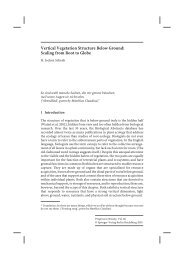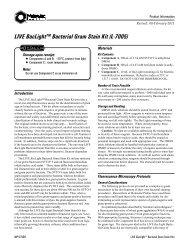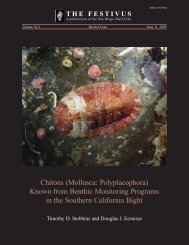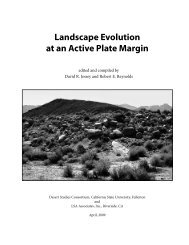Course Syllabus - Biological Science
Course Syllabus - Biological Science
Course Syllabus - Biological Science
Create successful ePaper yourself
Turn your PDF publications into a flip-book with our unique Google optimized e-Paper software.
Written assignments will require research of the primary literature and could also involve<br />
reanalysis of related data sets.<br />
<strong>Course</strong> Organization - The course will be organized as follows into four phases:<br />
1. Introduction to the physical and biological features of marine ecosystems relevant to<br />
the principles of phylogeographic analysis (Led by instructor, weeks 1-4)<br />
2. Investigation of particular research articles from the primary literature related to Baja<br />
phylogeography (Led by enrolled students, weeks 5-13)<br />
3. Student presentations (15-20 minutes each) of final projects, emphasizing the<br />
phylogeography of a particular taxon of marine organisms and based on original<br />
reanalysis of one or more selected primary research articles.<br />
Approximately the first four sessions will be devoted to an overview of basic concepts in<br />
marine phylogeography, with some emphasis on the West Coast of North America,<br />
including aspects related to local southern California marine habitats. Specific readings<br />
will be assigned for these introductory sessions, and these will be distributed as<br />
photocopies the week before they will be covered if not posted in pdf format to the<br />
“<strong>Course</strong> Documents” section of the <strong>Course</strong> website.<br />
Weekly Written Synopses – Starting with week 2 and ending with week 13, you will be<br />
expected to read the weekly assigned article(s) and write a synopsis and discussion of the<br />
main points, to be turned in at the start of the class when the article(s) will be discussed.<br />
The format you choose in your write-up is up to you. The score you receive for each<br />
synopsis write-up will be based on the following rubric (20 points possible):<br />
1) Do you provide an accurate overview of the main points from the assigned reading,<br />
including discussion of alternative hypotheses that are addressed, the source of new<br />
data analyzed, results obtained, and discussion of their implications? Do you<br />
appropriately cite the article? Do you provide a concise and original synopsis of the<br />
important conclusions avoiding merely quoting long portions of the assigned reading?<br />
(8 points)<br />
2) Do you build on the previous readings and seminar discussions, for example, do you<br />
address questions raised in either the assigned reading or in seminar discussion? Does<br />
the research article(s) help in comparing or contrasting terrestrial and marine patterns,<br />
or the patterns observed by different taxa within one of these categories? (3 points)<br />
3) Do you offer a critical analysis of the significance of this article relative to previous<br />
studies, for example, those cited by the author(s)? Are previous interpretations of<br />
phylogeographic pattern further supported or contradicted? If contradicted, are the<br />
new hypotheses or evidence compelling in providing a more general explanation for<br />
the pattern or does it more likely apply only to the specific case investigated? Do you<br />
appropriately use citations for ideas that come from other people? Do you summarize<br />
the important conclusions of previous articles in your own words rather than quoting?<br />
(3 points)<br />
2
















